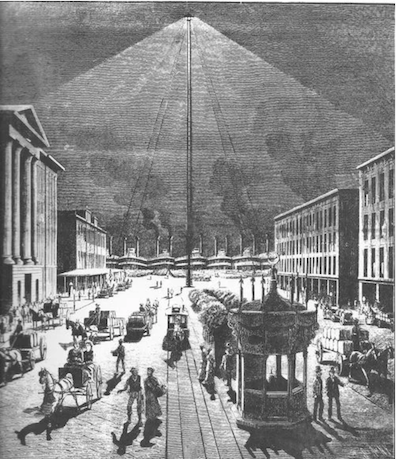In the early 20th century, as electric power ramped up in
cities and began to penetrate parts of the countryside, two
types of lights competed for market share. In Circe
Bloom stands in the street under the older type, a "bright
arclamp." The newer incandescent bulbs, which eventually
prevailed, show up in Nestor when Stephen remembers
reading "under glowlamps" in the Sainte Geneviève library in
Paris. Ithaca mentions both kinds: "the light of arc
and glowlamps."
In the first decade of the 19th century Sir Humphry Davy, an
English inventor, developed a workable electric light in which
current arced across the gap between two carbon rods. (Davy
originally called his invention the "arch lamp," because the
flow of superheated air around the current caused it to bend.)
Arc lamps were noisy and dangerous, but they emitted a harsh,
bright light that could illuminate city streets, and they were
cheaper than gaslights.
Paris and London began to install them in 1878, and Dublin
followed in 1880, building a succession of bigger power
stations to feed the growing number of electric
streetlights, and perhaps some indoor lights as well. (Indoor
arc lights caused a number of fires in European buildings in
the late 19th century.)
In 1880 Thomas Edison and Joseph Swann received a patent for
their incandescent lamp, which used electric current to heat a
carbon filament inside a vacuum bulb. Other inventors had been
experimenting with incandescent bulbs since the 1830s, but
Edison's design proved efficient and affordable. Eventually,
better designs employing tungsten filaments made incandescent
bulbs an attractive choice for streetlights, but arc lamps
produced much more light, so they remained the choice in many
cities' streetlights well into the 20th century. Today,
sodium- and mercury-vapor lights, both of them types of arc
lamps, are often used in streetlights.
The discussion between Stephen and Bloom in Ithaca
about "the influence of gaslight or the light of arc and
glowlamps on the growth of adjoining paraheliotropic
trees" suggests that both types of electric streetlight could
be found in Dublin in 1904. Indoors, the primary competition
for incandescent bulbs was gas. Slote, Mamigonian, and Turner
note that in the first years of the 20th century the "glowlamps"
of the reading room of the Sainte Geneviève library mentioned
in Nestor were actually "gas lamps, not electric."

